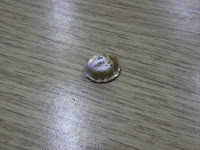My mum spotted a necklace in M&S. She liked the style, but the colours didn't match what the person she was buying for liked so I volunteered to make something for her, in the required green. It turned out I didn't actually have a lot of green beads in my stash. I asked what other colours she liked: "orange, black, ivory, lemon". This isn't a great combination, so I decided on dark green, amber, and black (the recipient is a green-eyed redhead). Then I went shopping.
It turned out I could buy beads individually at Beads Unlimited, so I went searching for a selection of oval, round, and faceted beads in my chosen colours. The next step was to figure out how I wanted to string them.

On the original necklace the beads were strung on transparent cord, with black cord knotted around them. I'd decided not to replicate this as it was fiddly and also meant some of the beads didn't hang right. I'd decided to string directly onto the main cord instead. Unfortunately I'm a really bad judge of size, so the beads turned out to be smaller than I expected. This wasn't a problem, except I had to go hunting for cord thin enough to string them on, and that meant the cord of the necklace would be thinner than I wanted and risk digging into the wearers neck.
In the end I stuck to the plan of stringing the beads onto their separate cords and knotting between them, and then plaiting the three threads together to make the rest of the necklace a bit thicker. This was the result.

For the clasp I made a loop in the cord, and added a random, reasonably-sized, green bead from my stash as the toggle. You can't see in the picture, but it has a spiral pattern.

One minor tweak later (moving the green beads by the toggle down to where the cords meet in the second picture) and it was ready to go.
















